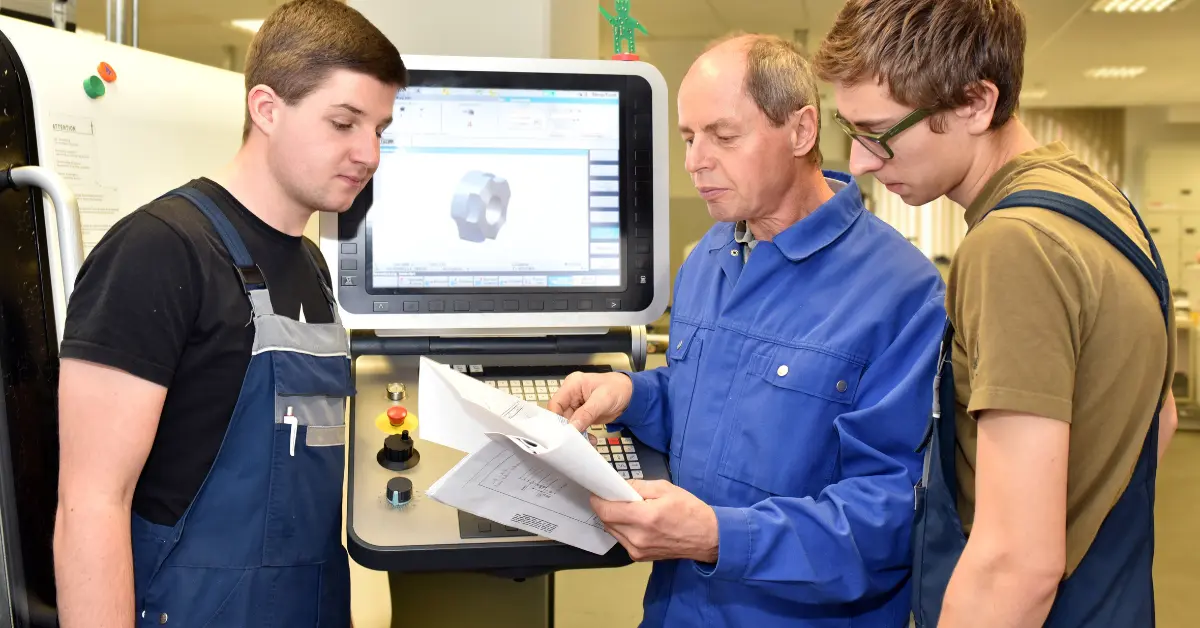Why traditional scheduling systems don't work for custom manufacturers
Over the years I have made it my goal to help manufacturers, specifically custom manufacturers improve their shops and their manufacturing practices, to help them streamline their organizations and ultimately grow their businesses. There is little else in my professional life that is as satisfying as seeing a manufacturer transform their shop, grow their business and reach their goals.
The problem: traditional scheduling systems work in theory only
But one of the major stumbling blocks for custom manufacturers is the struggle with scheduling. For the past 30 years I have repeatedly run into growing manufacturers that know they are wasting time, not servicing their customers as well as they could be, and sometimes even losing business because it’s too hard for them to predict costs, and to provide reliable delivery dates to their customers.
At university they taught us the different methods and strategies to schedule a manufacturing shop—finite scheduling, infinite scheduling, ASAP strategy, JIT strategy with a bill of material, with routing steps using a work center, competencies, constraints. We all sharpened our pencils and spent hours and hours diligently learning these concepts and methodologies. That time wasn’t completely wasted, but unfortunately, these strategies are good in theory, but that’s about it.
They don’t work in the real world because busy custom manufacturing shops don’t have the perfect data sets that are needed for these scheduling models to work. Custom shops, by their very nature, are constantly building new products from scratch, so they do not have complete data from past jobs to rely on, making it next to impossible to create accurate schedules. All of which means it is tough to quote accurately and to provide their customers with precise delivery dates. So what works great on paper in a classroom, just leads to a lack of cohesion and problems on the shop floor.
Check out the best manufacturing ERP modules to include in your requirements
We all know the saying “garbage in, garbage out.” That is essentially the core of the problem custom manufacturers face. The complex algorithms most scheduling systems rely on require accurate data to plug into the system. Not a problem if you are repeating the same products day after day. Big problem if you are building something for the first time.
Scheduling: mission impossible for custom manufacturers
Let’s take an example of a typical manufacturer that I work with. This company is fabricating parts, making sub-assemblies, and then a final assembly using hundreds of parts with multiple operations. A product like this would have a huge BOM and many different jobs, so thousands of tasks that need to be scheduled. A typical manufacturer would use a scheduling system based on a theory such as Just-in-Time (JIT) and an algorithm would quickly calculate start dates, end dates, and time required per resource.
But, they are dealing with a lot of unknowns since many of the parts that they are fabricating are being done for the first time—meaning they have no reliable data in place when the job starts. To get around this problem they plug in ‘averages’ or ‘rules of thumb’ to feed the algorithm.
So all the scheduling algorithm can really do is use these imprecise numbers to calculate what turns out to be ‘wrong’ dates. And because the final product is reliant on all the parts and sub-assemblies, wrong dates start piling up on top of other wrong dates, causing cascading changes, further delays and missed deadlines.
And on top of that, customers are always calling to try to get their order pushed up faster than expected, meaning they are constantly in flux trying to rework schedules to get jobs out the door as fast as they can.
In this age of modern technology, I would like to be able to say that everything is paperless, but a lot of trees are still being killed every day so that plant managers can have a piece of paper on hand with the day’s schedule printed out on it.
You know the document I am talking about: the ‘Traveller’ that you share with your staff, telling everyone what is required, what has to be done and when it has to be done. This document normally shows dates and times, and at the beginning of every shift things start out smoothly enough. Operation #1 should start on Monday at 7:30 and end at 11:00, operation #2 should start at noon on Monday (oops, this really should say at 1:00pm because the capacity of the work center for operation #2 says that Johnny, the machinist, is at lunch from noon to 1:00), and so forth.
Hundreds of parts, hundreds of Travellers circulating in the shop and everything seems to be going to plan until it isn’t. A deadline is missed (remember Johnny’s lunch break?), and then a customer calls and asks why their order is delayed, meaning the priorities of the shop floor are now rearranged. What started off as the schedule for the day gets crumpled up and thrown out, meaning back to the drawing board to create another new schedule.
Now, tell me how can you effectively communicate all these changes to your staff, your team, and the people on the line? You need to make sure that everyone resets all operational dates, start times and end times. You reprint all the Travellers and you hopefully get the old ones back, so that everyone is on the same page again, so to speak. We all know in reality that the latest version of the huge Gantt Chart printed on the wall in the production manager’s office looks nice when a customer comes for a visit but that no one really uses it, because things are always changing too fast in an actual manufacturing environment.
Traditional scheduling should just be called rescheduling. It’s much more realistic.
The solution: Drum Buffer Rope scheduling simplifies scheduling for manufacturers
We all hate people that can tell you everything about the problem, but don’t actually bring you any solutions. So I won’t be that guy.
I really do believe there is a smarter and easier way for custom manufacturers to schedule their shops. It’s called Drum Buffer Rope, DBR for short. It is based on Eli Goldratt’s Theory of Constraints (TOC) and it removes the complex algorithms that traditional scheduling systems use, and replaces all of that with a simple concept: find the heartbeat of your shop and schedule around it.
DBR simplifies scheduling for custom manufacturers because it eliminates the need for accurate data, gives custom shops a better priority management system, and makes it easier for shops to deal with on-the-fly changes.
Instead of trying to force inaccurate data into complex algorithms, DBR scheduling looks at your plant as a whole and identifies the Drum—basically the heartbeat of your shop. This Drum can be defined as one, or a limited number of, scarce resources or constraints, that control the overall output of your shop. The pace of that Drum sets your pace of production. DBR scheduling streamlines the scheduling process by identifying a plant’s most limited resource, and then automatically generates a schedule around this resource.
In TOC terms, the performance of the system's Drum will determine the performance of the system as a whole, so if you speed up, for example the work center that is holding you back, you speed up the entire shop. Therefore, to ensure your shop is running at its maximum capacity you need to prioritize your biggest constraint, and ensure that that resource is always running at maximum capacity.

A DBR scheduling tool then applies Buffers and Ropes around the Drum to ensure that it is always the priority. A Buffer is a period of time that is designed to protect the Drum against delays and other problems. A correctly set buffer ensures that jobs will always pass through the Drum at the correct pace. Ropes are processes that allow jobs to flow seamlessly through a shop, which you can think of as imaginary strings that connect everything in your shop and ensure that everything is moving in the right direction at the right rate.
DBR scheduling lets you better manage priorities in your shop and lets you quickly adapt or adjust a schedule based on customer demands, because you don’t have to rework an entire schedule, you just need to adjust buffers and ropes to ensure that your Drum is always running at maximum capacity.
Read more of the benefits of manufacturing ERP with our free guide
With DBR scheduling every department in a custom manufacturing shop will also be better equipped. Managers and supervisors will be better able to set and manage priorities as well as define and follow the throughput of their shop. Project managers will be able to determine, set and follow milestones. Front office staff will be able to provide more accurate quotes and estimated delivery dates, keeping customers happier, and ensuring growing manufacturers don’t lose business because of reliability issues.
And because the schedule is no longer based off of inaccurate data, but instead on how jobs actually move through the shop, coupled with the built-in buffers and ropes, there are less changes to communicate to your staff (say goodbye to ever-changing travelers). The schedule is built to absorb the inconsistencies that inevitably come with custom manufacturing, meaning less changes and scrambling on the shop floor. Production staff will always know what job to work on, what job needs to be done next, and will never have to question what their top priorities are.
To cut a long story short, DBR scheduling means:
- Decreased lead time;
- Increased throughput;
- A more harmonious shop with everyone aligned and working on the same priorities;
- Increased customer satisfaction;
- Reduced WIP; and
- Increased cash flow.
Getting scheduling right is one of the biggest things a custom shop can do to get more jobs completed and out the door on time. Rethink what you learned in school, and instead apply principles and processes that actually work in the real-world of a custom manufacturing shop.
Free white paper

Manufacturing ERP requirements template
Over 120 critical manufacturing ERP features in one downloadable spreadsheet

Featured white papers
Related articles
-

ERP capacity planning and scheduling
The different types of capacity planning and how this impacts scheduling
-

CMMC Compliance: What Aerospace and Defense Manufacturers Need to Know
Key insights on CMMC compliance, deadlines, and securing DoD contracts with CMMC 2.0 certificatio...
-

4 training tips for manufacturing ERP success
These four training tips will help your employees get the most out of your new manufacturing ERP ...




